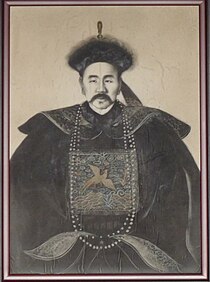| Origin | Qing dynasty |
|---|---|
| Representative figures | Hu Xueyan |
Red hat merchant [1] (Chinese: 紅頂商人; hong-ding shangren), alternatively translated as red-hat businessman, [2] entrepreneur with red hat, [3] refers to a government official who also appears as a businessman, combining the roles of civil servant and businessman, that is, "government businessman". [4]

The term originated from the Qing dynasty and was initially used to describe state officials who were also engaged in commercial activities. [5] At that time, wealthy officials often wore caps with rubies. [6] The typical representative of the "red hat merchant" is Hu Xueyan, a prominent businessman in the late Qing dynasty. [7]
Nowadays, the term "red hat merchant" is widely used to refer to a businessperson who benefits from good relationships with important high-level government officials. [8] The term is also used to refer to businesspeople who hold top positions in local companies and local government financing vehicles. [9]: 53
- ^ Michael Dillon (1 December 2016). Encyclopedia of Chinese History. Taylor & Francis. pp. 303–. ISBN 978-1-317-81716-1.
- ^ Elie Virgile Chrysostome; Rick Molz (16 April 2014). Building Businesses in Emerging and Developing Countries: Challenges and Opportunities. Routledge. pp. 116–. ISBN 978-1-136-16885-7.
- ^ Cheng Li (7 July 2006). "Reshuffling Four Tiers of Local Leaders:Goals and Implications" (PDF). Hoover Institution.
- ^ "Contemporary "Hu Xueyan" persons". Deutsche Welle. 18 September 2010.
- ^ G. E. Anderson (19 June 2012). Designated Drivers: How China Plans to Dominate the Global Auto Industry. John Wiley & Sons. pp. 3–. ISBN 978-1-118-32885-9.
- ^ "8,000 Chinese officials quit business posts". People's Daily Online. 29 December 2004.
- ^ "Folly of blindly chasing profits". The Standard. 30 July 2020.
- ^ Crime, Law and Social Change (27 April 2021). "The changing forms of corruption in China". Springer.com. Vol. 75, no. 3. pp. 247–265. doi: 10.1007/s10611-021-09952-3.
- ^ Chen, Muyang (2024). The Latecomer's Rise: Policy Banks and the Globalization of China's Development Finance. Ithaca and London: Cornell University Press. ISBN 9781501775857. JSTOR 10.7591/jj.6230186.
| Origin | Qing dynasty |
|---|---|
| Representative figures | Hu Xueyan |
Red hat merchant [1] (Chinese: 紅頂商人; hong-ding shangren), alternatively translated as red-hat businessman, [2] entrepreneur with red hat, [3] refers to a government official who also appears as a businessman, combining the roles of civil servant and businessman, that is, "government businessman". [4]

The term originated from the Qing dynasty and was initially used to describe state officials who were also engaged in commercial activities. [5] At that time, wealthy officials often wore caps with rubies. [6] The typical representative of the "red hat merchant" is Hu Xueyan, a prominent businessman in the late Qing dynasty. [7]
Nowadays, the term "red hat merchant" is widely used to refer to a businessperson who benefits from good relationships with important high-level government officials. [8] The term is also used to refer to businesspeople who hold top positions in local companies and local government financing vehicles. [9]: 53
- ^ Michael Dillon (1 December 2016). Encyclopedia of Chinese History. Taylor & Francis. pp. 303–. ISBN 978-1-317-81716-1.
- ^ Elie Virgile Chrysostome; Rick Molz (16 April 2014). Building Businesses in Emerging and Developing Countries: Challenges and Opportunities. Routledge. pp. 116–. ISBN 978-1-136-16885-7.
- ^ Cheng Li (7 July 2006). "Reshuffling Four Tiers of Local Leaders:Goals and Implications" (PDF). Hoover Institution.
- ^ "Contemporary "Hu Xueyan" persons". Deutsche Welle. 18 September 2010.
- ^ G. E. Anderson (19 June 2012). Designated Drivers: How China Plans to Dominate the Global Auto Industry. John Wiley & Sons. pp. 3–. ISBN 978-1-118-32885-9.
- ^ "8,000 Chinese officials quit business posts". People's Daily Online. 29 December 2004.
- ^ "Folly of blindly chasing profits". The Standard. 30 July 2020.
- ^ Crime, Law and Social Change (27 April 2021). "The changing forms of corruption in China". Springer.com. Vol. 75, no. 3. pp. 247–265. doi: 10.1007/s10611-021-09952-3.
- ^ Chen, Muyang (2024). The Latecomer's Rise: Policy Banks and the Globalization of China's Development Finance. Ithaca and London: Cornell University Press. ISBN 9781501775857. JSTOR 10.7591/jj.6230186.